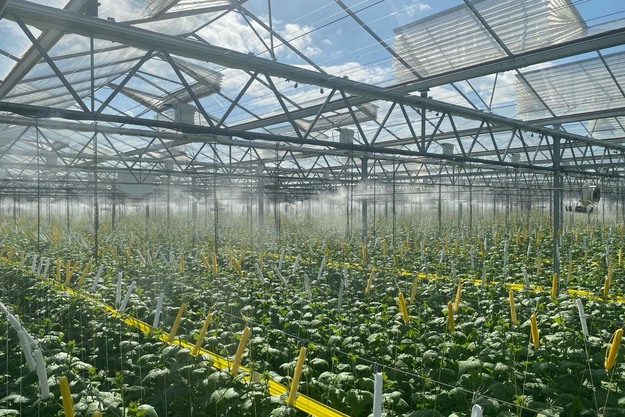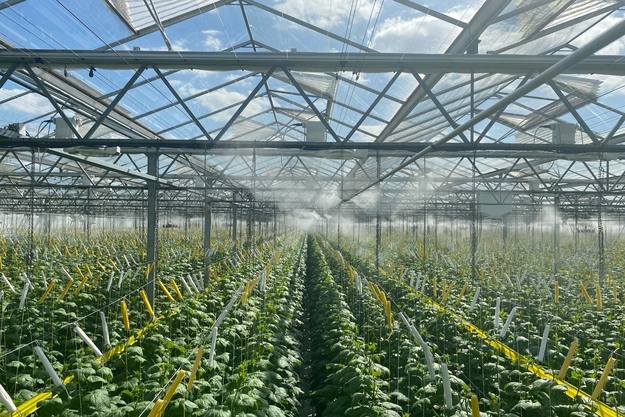The weather has been warm lately—just like earlier this year—and more is expected in the coming weeks. Temperature data from recent years, along with climate projections, show that even in the Netherlands, longer periods of heat and drought are becoming more common. As a result, more growers are turning to techniques to cool their greenhouses, and high-pressure misting has become a popular solution.
 © MJ Tech
© MJ Tech
Dry and Warm Conditions
"This spring was both dry and warm. If you can then lower the temperature, increase humidity, and retain CO₂ inside the greenhouse, you can give your crop a real boost," explains Rob Kwinten of MJ-Tech, who supports growers in implementing misting systems. "Misting helps keep the stomata of the plant open, which maintains transpiration and CO₂ uptake."
Comparative trials between greenhouse sections with and without misting show that plant temperatures stay lower on hot days. On subsequent days, plants in the misted section show more transpiration, resulting in lower plant temperatures.
According to Rob, the flexibility of MJ-Tech's misting systems makes them suitable for a wider range of applications and longer use throughout the year. "Older systems required misting for at least 15 seconds at a time, but that's no longer necessary. By misting briefly and frequently, you can control the climate much more precisely. And if that means you can ventilate less and retain more CO₂, then it's a win-win."
From 38 to 32.5 Degrees
Marcel Huibers, cucumber specialist at seed breeder BASF/Nunhems, recalls using misting during his time at Hortus in Futuro in Maasbree—one of the first cucumber farms to install an MJ-Tech system. "I remember days when it was over 38°C outside, but inside the greenhouse it never got hotter than 32.5°C. That's a significant difference."
Since then, more cucumber growers have adopted misting systems. It makes sense: cucumbers have large leaves and stomata that close quickly, so keeping the plant active is essential. Still, some growers remain cautious, worried that too much moisture might lead to "lazy" plants that stop transpiring.
"That concern comes from the past, from the days of the 'minimum 15-second misting' myth," Rob explains. "Today, misting volume and duration are tailored to the grower's needs, the climate, and the crop's requirements." This flexibility also means misting can be used during a much larger part of the year. "In drier conditions, you can run the system for just 5 seconds to retain a bit of moisture and reduce the need for ventilation."
Marcel agrees: "You mist to activate the plant, not to take over. The goal is to increase transpiration, not reduce it." The key is to mist just enough to influence the climate without wetting the plants. "The mist should evaporate before reaching the plant—it's that evaporation that creates the cooling effect."
He compares it to standing in a shower. "You don't feel cold in a sealed shower cabin. But the moment you open the door and enter lower humidity, the moisture on your skin begins to evaporate, which uses energy and cools you down. That's exactly how it works in the greenhouse: cooling comes from evaporation, not from wet plants." That's why correct system settings are critical. "The taller the greenhouse, the longer the mist pulses can be, giving the mist more time to evaporate before it reaches the plants."
Looking ahead, Marcel sees another benefit: keeping plant temperatures lower can allow growers to close the energy screen later in the day.
 © MJ Tech
© MJ Tech
Mesh-Covered Greenhouses
Marcel also notes that misting systems are being used more widely. "In recent years, cucumber greenhouses are increasingly covered with insect netting, which reduces ventilation capacity. Misting can help compensate for that."
At the same time, rooftop irrigation is falling out of favor. It's less efficient, less stable, and carries the risk of untreated water entering the greenhouse. It also uses large amounts of water at a time when reservoirs may be running low.
An issue that wasn't as prominent a few years ago but is now increasingly important is CO₂ retention—both for sustainability and cost reasons. "You want to keep as much CO₂ in the greenhouse as possible. Misting lets you reduce ventilation, making your CO₂ use more efficient."
Rob adds, "When you retain CO₂, you can also make better use of available light. With enough CO₂, light, and humidity, you can really maximize photosynthesis."
For more information:
Rob Kwinten 
MJ-Tech
robkwinten@mjtech.nl
www.mjtech.nl
